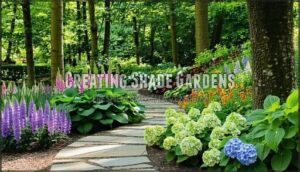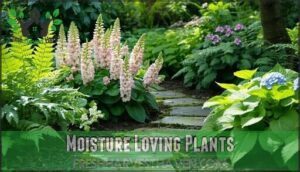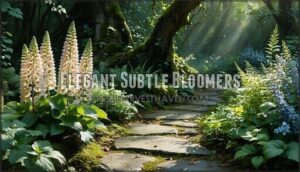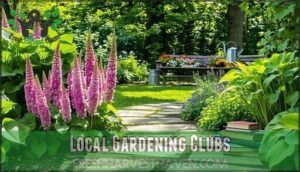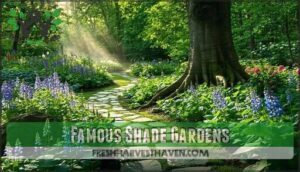This site is supported by our readers. We may earn a commission, at no cost to you, if you purchase through links.
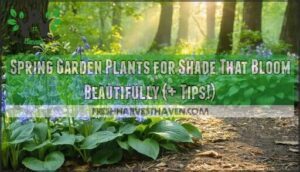
Spring garden plants for shade include early bloomers like hellebores and bloodroot that emerge before trees leaf out, offering months of color.
Bleeding hearts add whimsical charm with their heart-shaped flowers, while coral bells provide colorful foliage all season.
Don’t overlook ground covers like wild ginger and ajuga that’ll carpet bare areas beautifully.
Virginia bluebells create stunning blue carpets in woodland settings, and lungwort offers spotted leaves with pink-and-blue flowers.
These shade lovers actually prefer gentle filtered light over harsh sun, making your challenging spots some of the garden’s most enchanting areas.
The secret lies in understanding each plant’s specific moisture and light needs to create a thriving environment, and by doing so, you can turn your shady spots into the garden’s most enchanting areas with colorful foliage.
Table Of Contents
Key Takeaways
- You’ll enjoy months of color starting in late winter – Early spring bloomers like hellebores and bloodroot emerge before trees leaf out, giving you blooms from February through spring when most gardens are still dormant.
- Your shade doesn’t limit plant choices, it expands them – Plants like bleeding hearts, Virginia bluebells, and coral bells actually prefer gentle filtered light over harsh sun, making your challenging spots ideal for these beautiful specimens.
- You can create low-maintenance ground cover that works double-duty – Wild ginger, ajuga, and sweet woodruff spread naturally to carpet bare areas while suppressing weeds, reducing your garden maintenance.
- You’ll need to match each plant’s specific moisture and light requirements – Success comes from understanding that some shade plants need consistently moist soil while others tolerate drier conditions, so evaluate your garden’s microclimate before selecting plants.
Shade Garden Plants
You’ll discover that shade gardens offer incredible opportunities for vibrant spring blooms, even without direct sunlight.
These carefully selected plants thrive in low-light conditions while delivering stunning colors and textures that rival any sunny border.
Early Spring Bloomers
When winter’s grip loosens, early spring bloomers emerge as nature’s first messengers in shaded gardens.
Hellebore care proves simple—these tough perennials handle cold snaps while producing nodding blooms. Primrose blooms brighten dark corners with cheerful colors, thriving beneath deciduous trees.
Spring arrives early in shaded gardens, bringing tough perennials that laugh at cold snaps while painting dark corners with joy.
Native treasures like Hepatica nobilis and Twinleaf flowers appear almost overnight, while Mayapple growth creates distinctive umbrella leaves.
Understanding shade garden plants is essential for selecting the right shade loving plants. These shade garden plants kickstart your spring garden beautifully, with early spring bloomers.
Unique Whimsical Flowers
After those cheerful early bloomers establish your garden’s foundation, you’ll want to add personality with truly unique specimens.
Bleeding Heart dangles romantic pink hearts, while Dutchman’s Breeches look like tiny white pantaloons hanging on a line.
Shooting Star sends purple blooms skyward, and Columbine attracts hummingbirds with spurred petals.
Toad Lily offers exotic spotted flowers, Virginia Bluebells provide delicate blue bells, and Corydalis adds graceful yellow touches.
Ground Cover Options
Several creeping plants transform bare shade ground into living carpets that practically maintain themselves.
Wild Ginger’s heart-shaped leaves create dense weed suppression, while Sweet Woodruff spreads quickly with fragrant foliage. These low maintenance shade perennials offer diverse foliage textures—from Ajuga’s glossy mats to Japanese Forest Grass’s soft arches.
Smart shade garden plants like Solomon’s Seal and Foamflower establish beautiful spring shade plants that work double-duty as effective shade ground cover.
For ideal growth, understanding shade garden requirements is essential to create a thriving environment with low maintenance shade perennials, including dense weed suppression and beautiful spring shade plants.
Creating Shade Gardens
Creating a shade garden transforms forgotten corners of your yard into thriving, colorful spaces that’ll surprise even experienced gardeners.
You’ll discover that shade doesn’t mean sacrificing beauty—it means choosing plants that actually prefer cooler, protected spots over blazing sun, and this realization can lead to the creation of truly unique and colorful spaces.
Tree Canopies Importance
Tree canopies create natural Shade Patterns through their Forest Structure, with Canopy Layers filtering sunlight at different levels.
Nature’s architects design perfect shade sanctuaries through layered canopies and filtered light.
Your shade garden plants benefit from this dappled light, while Tree Roots create microclimates below.
Leaf Density changes seasonally, affecting spring shade plants differently than summer bloomers, which helps in understanding these natural systems to work with nature’s blueprint when selecting shade perennials and shade-loving plants for successful shade gardening.
Choosing Right Plants
When matching shade garden plants to your specific conditions, you’ll want to think like a matchmaker connecting the perfect partners.
Start by evaluating your garden’s unique microclimate and understanding each plant’s specific needs for ideal performance.
Consider these essential factors for plant selection:
- Shade tolerance levels – Match plants to your garden’s light conditions, from dappled morning sun to deep afternoon shadows
- Soil preferences – Check drainage needs and pH requirements before planting shade-tolerant plants like astilbe or hostas
- Plant hardiness zones – Verify that perennial flowers for shade can survive your local winter temperatures for long-term success
For ideal results, consider using native plant species to create a thriving ecosystem.
Water Features Role
While bubbling fountains can’t replace sunlight, they’ll breathe life into your shade garden design. Consider fountain installation near seating areas where you’ll hear gentle water sounds.
Rain chains guide water beautifully from gutters, while waterfall creation adds drama to sloped areas.
Stream planning connects different garden zones, and pond design creates focal points where shade loving plants thrive in moist conditions.
Shade Tolerant Flowers
You’ll find that shade-tolerant flowers can transform those dim corners of your yard into colorful havens, even without direct sunlight.
Many of these plants actually prefer cooler, shadier conditions and will reward you with stunning blooms throughout the spring season.
Moisture Loving Plants
Your shade loving plants thrive when soil moisture stays above 40%.
Astilbe and damp ferns flourish in consistently wet conditions, while shade hydrangea tolerates brief waterlogged periods.
Most woodland plants need weekly watering during dry spells, even in shaded spots.
Wet landscaping with proper drainage prevents root rot while maintaining the moist soil these partial shade plants crave.
Understanding shade loving plants is essential for creating a thriving garden in shaded areas.
Virginia Bluebells Care
Successfully caring for Virginia bluebells requires understanding their unique spring flowers cycle and woodland plants needs.
These shade loving plants thrive with proper soil preparation and water management during their brief but spectacular bloom period.
- Soil Preparation: Mix rich compost into well-draining soil before planting these delicate beauties
- Water Management: Keep soil consistently moist during spring growth, then reduce watering after dormancy
- Mulch Benefits: Apply leaf litter mulch to mimic their natural forest floor environment
- Pest Control: Watch for slugs on tender new shoots during damp spring weather
- Fertilization: Skip heavy feeding—these shade garden ideas stars prefer gentle compost top-dressing for ideal shade plant care
Lungwort Requirements
Lungwort thrives when you match its soil needs with rich, organic matter and proper water levels.
This shade plant demands consistent moisture but won’t tolerate soggy conditions.
Its excellent shade tolerance makes it perfect for full shade plants collections.
Add compost annually to boost humus content, and your lungwort will reward you with spotted leaves and colorful blooms that brighten any shade garden.
Consider companion planting with herbs that benefit from minimal sunlight conditions.
Elegant Subtle Bloomers
You’ll love how these understated blooms create a dreamy, ethereal feeling in your shade garden without competing for attention.
Their soft colors and gentle textures work together like a peaceful symphony, making even the darkest corners feel magical.
Woodland Phlox Beauty
Woodland Phlox transforms your shade garden into a peaceful retreat with its soft, pastel blooms that whisper rather than shout.
This reliable performer delivers delicate flower colors in blues, purples, and whites throughout spring.
Phlox care couldn’t be simpler—just plant it in moist, well-draining soil and watch it spread naturally, creating dreamy garden design elements.
Perfect for woodland plants collections, it makes a great addition to any garden.
Meadow Rue Delicacy
Through dappled sunlight, Meadow Rue brings ethereal beauty to your shade garden with its feathery texture and delicate foliage.
This shade-loving plant creates stunning woodland garden ideas through subtle spring blooms.
Garden Elegance Features:
- Wispy, cloud-like flower clusters that dance in gentle breezes
- Fern-like leaves creating soft, layered plant texture contrasts
- Pale purple or white blooms floating above silvery-green foliage
- Graceful stems reaching 2-4 feet, perfect for backdrop plantings
False Solomon’s Seal Elegance
False Solomon’s Seal grace transforms shade gardens with its architectural beauty.
You’ll love watching these perennials unfurl their arching stems each spring, creating natural sculptures beneath your trees.
The creamy blooms appear in late spring, offering subtle beauty that complements other shade loving plants perfectly.
For ideal False Solomons Seal care, provide rich, moist soil and pair with hostas or ferns for stunning shade plant combinations that showcase architectural beauty.
Shade Garden Design
You’ll want to connect with local gardening clubs for hands-on workshops and garden tours that’ll spark fresh design ideas for your shaded spaces.
Online forums and famous shade gardens like Portland Japanese Garden offer endless inspiration when you’re ready to transform that dark corner into something spectacular.
When considering transformation, remember that these resources provide a foundation for creating unique and inspiration-filled spaces.
Local Gardening Clubs
Joining gardening clubs opens doors to hands-on Gardening Workshops where you’ll master shade garden plant selection techniques.
These groups host Community Events featuring Plant Sales with rare specimens and expert-led sessions on shade garden design tips.
Club Membership connects you with seasoned gardeners who share shade garden inspiration through Gardener Networking. You’ll discover which plants thrive in your specific climate while building lasting friendships within the garden community.
Many gardeners benefit from official Gardening Club resources and support.
Online Forums Inspiration
Your keyboard becomes a gateway to endless shade garden inspiration when you tap into online communities.
Digital gardening spaces offer instant access to expert advice, troubleshooting help, and creative ideas from fellow shade gardeners worldwide.
- Forum Tips from experienced gardeners provide practical solutions for common shade garden challenges
- Garden Communities on social media platforms share real photos and success stories for authentic inspiration
- Online Resources like web workshops teach advanced shade garden design tips and plant selection strategies
- Social Media groups offer quick answers and shade garden strategies for immediate problem-solving needs
Effective garden planning involves considering spring garden design to create a beautiful and thriving outdoor space.
Famous Shade Gardens
You’ll find incredible shade garden design inspiration by visiting famous landscapes like Portland Japanese Garden and Sissinghurst Castle Garden.
These historic gardens showcase masterful combinations of shade-loving plants, from Virginia bluebells to Solomon’s seal.
Garden tours reveal how experts layer textures and colors under tree canopies, giving you fresh ideas for your own shaded spaces.
Frequently Asked Questions (FAQs)
What garden plants do well in shade?
Like medieval monks tending monastery gardens, you’ll find plenty of shade-loving plants thrive without full sun.
Try hostas, ferns, astilbe, and coral bells for reliable performers that’ll create lush, colorful displays.
How do I prevent slugs damaging shade plants?
You’ll battle these slimy garden invaders with copper tape barriers, beer traps, and crushed eggshells around vulnerable plants. Hand-pick slugs at dawn when they’re most active.
When should I divide spring shade perennials?
You won’t kill them by waiting! Divide spring shade perennials in early fall when they’re establishing roots, or early spring before active growth begins. Avoid dividing during flowering periods.
What fertilizer works best for woodland flowers?
You’ll want organic, slow-release fertilizer for woodland flowers. Compost or balanced 10-10-10 works perfectly. Apply in early spring before growth starts, then mulch with leaf mold.
How deep should I plant shade bulbs?
Plant shade bulbs at a depth three times their height.
A two-inch bulb goes six inches deep, while smaller ones need three to four inches.
This gives roots proper anchoring and protection from temperature swings.
Can I grow vegetables in partial shade?
Where there’s a will, there’s a way! You’ll definitely succeed growing leafy greens, herbs, and root vegetables in partial shade. They’ll thrive with 3-6 hours of sunlight daily.
Conclusion
Picture Sarah’s dark north-facing yard that seemed hopeless for flowers.
After planting spring garden plants for shade, she now enjoys months of blooms starting with early hellebores in February.
You’ll discover that shade gardening isn’t limiting—it’s liberating.
These hardy perennials return year after year, creating stunning displays with minimal maintenance.
Your shady spots can become the garden’s most peaceful, colorful retreats where spring garden plants for shade truly shine.

